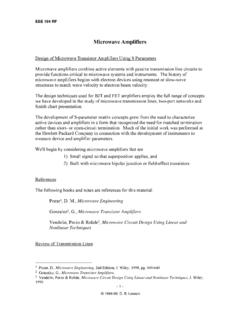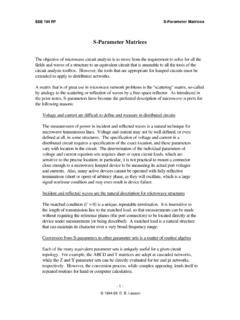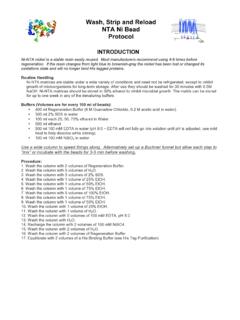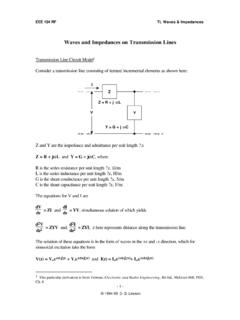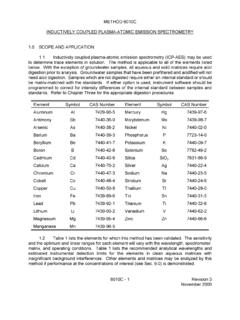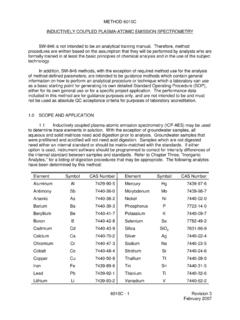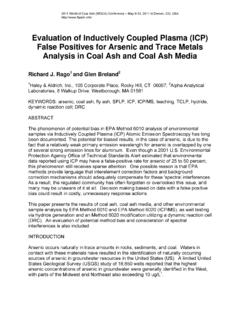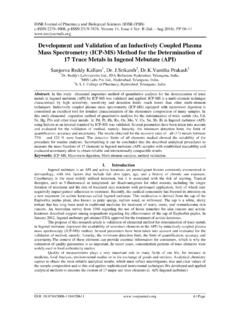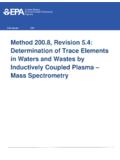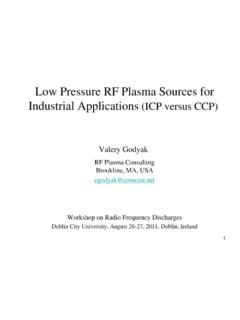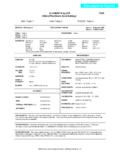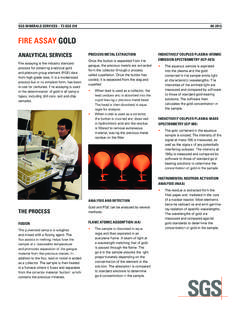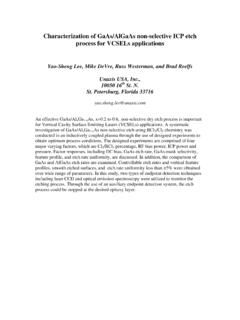Transcription of Plasma Sources Sci. Technol. 9 Introduction to gas …
1 Plasma Sources Sci. (2000) 517 527. Printed in the UKPII: S0963-0252(00)15592-6 Introduction to gas dischargesN St J BraithwaiteThe Open University, Oxford Research Unit, Foxcombe Hall, Boars Hill, Oxford OX1 5HR,UKReceived 1 December 1999, in final form 13 June is a tutorial article. An introductory discussion of direct current gasdischarges is presented. Beginning with basic ideas from kinetic theory, gas dischargeplasmas are described in terms of phenomena observed in the laboratory. Various models areintroduced to account for electrical breakdown, Plasma boundaries and the longitudinal andtransverse structure of IntroductionThis article is intended to set the scene for more detaileddiscussions about the physics of laboratory plasmas.
2 Thereare many types of Plasma source such as those basedon discharges created by direct current (dc), capacitivelycoupled radiofrequency (rf) (RIE, PECVD), inductivelycoupled rf (ICP, TCP, Helicon) and microwaves (ECR,Surfatron).The technological applications of plasmasformed in these Sources are numerous and include thin filmdeposition, semiconductor processing, materials treatments(modification of surface physics and surface chemistry,sterilization), lamps, light Sources and displays, thick filmdeposition, waste treatment and materials section 2 some basic results from kinetic theory arerecalled. The nature of the Plasma state and of laboratoryplasmas in particular is described in section 3.
3 Sections 4and 5 examine the production and loss of charged particles,including the breakdown phase of a gas 6 the spatial structure of a steady state, self-sustainingdischarge is discussed, for medium and low pressure. A finalbrief section illustrates the flow of energy in a low-pressure,laboratory Just particlesThe kinetic description of a stationary gas considers largepopulations of gas atoms with a range (or distribution) ofspeeds moving in all directions. The distributions of speedand velocity are characterised by a mean energy, , whichis linked by the form of the distribution to the kinetictemperature,kT. Pressure,p, in a gas is a measure of thedensity of thermal energy associated with the number of gasatoms per unit volume,ng.
4 Thus,p=ngkT(1)(SI units:pis in Pa whenngis in m 3andkTis inJ; one pascal is equivalent to a joule per cubic metre).Similar concepts apply to charged particle populations. Inthe following some more useful rabbits are pulled out of thehat of kinetic theory. Use will be made of the following data: radius of argon atom,rAr= 10 10m; Boltzmann s constant,k= 10 23JK 1; mass of argon atom,MAr=40 10 27kg; mass of electron,m= 10 31kg; electronic charge, 10 Moving neutrals (in a thermalized group)At room temperature the average speed of an argon atom(atomic mass 40) is 102ms 1, v= 2kTM.(2)At a pressure of 1 Torr (130 Pa) the random flux of argonatoms at room temperature is 2 1025atoms m 2s 1, =n c4=n kT2 M.
5 (3)At a pressure of 1 Torr (130 Pa) the distance travelled byan argon atom between collisions will be on average mm, =14 ng(4) = r2Ar.(5)The frequency of collisions between gas atoms at roomtemperature is 106s 1, = v (6)A flow of neutrals arises when there are gradients in pressure( gradients in density and/or temperature). Moving chargesThe Introduction of charge changes a few things. First, chargeis a source of electric field through which every charge exertsforces on any other charges in inverse square proportionto their separation (r 2). Second, an externally imposedelectric field will apply forces to any charges that enter +11$ 2000 IOP Publishing Ltd517N St J BraithwaiteThird, charges that move relative to magnetic fields alsoexperience forces.
6 The Lorentz force conveniently combinesthe electric and magnetic effects for a chargeF=q(E+v B)(7)in which:qis the quantity of charge in coulombs;Eis electricfield in volts per metre;vis velocity in metres per second; here implies the vector product;Bis the flux density work is done on a charge it gains energy12mv2d=eV(8)wherevdis a drift velocity. The energyeVcan be gainedby moving a given distance,x1, in the direction of an electricfield:eV= x10eEdx.(9)Elastic collisions randomize particle motions leading to amean thermal speed as equation (2). Elastic and inelastic collisionsBy far the most common encounter in gases is betweenpairs of particles (binary collisions).
7 When particles interact(collide) momentum and energy must be conserved. Thereare three clear classes of event.(i) Elastic: momentum is redistributed between particlesand the total kinetic energy remains unchanged, fast+Aslow e less f ast+Aless slow.(ii) Inelastic: momentum is redistributed between particlesbut a fraction of the initial kinetic energy is transferredto internal energy in one or more of the particles ( states or ions are formed), fast+A e slower+A e slower+A++e .(iii) Superelastic: a third class also needs to be anticipated here there is more kinetic energy after the is conserved and internal energy in theparticles entering into a collision is transferred intokinetic energy, slow+Bslow Afaster+ analysis of binary collisions reveals some usefulgeneral points.
8 Lighter particles (m) cannot lose much energy elasticallyto heavier particles (M) at best a fraction 2m/M,nevertheless, substantial changes in momentum occur(cf tennis). A moving particle on striking elastically a stationaryone of equal mass head-on can transfer all of its kineticenergy (cf billiards). Lighter particles can lose virtually all their kinetic energythrough inelastic collisions with heavier objects (cfsandblasting). Equal mass particles can lose no more than half theirkinetic energy inelastically on collision (cf ion impactionization). Binary collisions in which at least one particle is chargedmay be dominated by long-range Coulomb of mean free Cross section and mean free path elastic collisionsA thorough study of collisions considering scattering anglesand impact parameters will be covered in a companion a simpler zeroth order approach is presented to accountfor the more general an electron moving through a number ofstationary argon atoms; see figure elasticencounters only will be dealt with here so the target atomsare viewed as hard spheres and the electron is assumed tobehave as a point mass; effects arising from its charge are notincluded.
9 The question to be addressed is how far the electroncan be expected to penetrate before having a number of target (argon) atoms in a cuboidxyzisngxyz. Each atom presents a cross section, r2Ar= ,obscuring the electron path. Viewed through the facexythetotal area blocked by atoms will bengxyz . When the cuboidextends as far as one mean free path ( ), virtually the entirefacexywill be obscured so(ngxy ) =xy =1ng (10)and the electron is very likely to have a collision(cf equation (4) which has a factor of four to account for thesize of the projectile atom). From equation (6), the frequencyof encounters can beestimatedfor projectiles, electrons inthis case, with a mean speed vv= vng.
10 (11)The scaling of mean free path and frequency of collisions withpressure, throughng, and energy, through v, are consistentwith practice cross sections are not actually independentof energy, even for elastic collisions. High-energy electronsspeed past so quickly that the chances of interacting with theouter shell electrons on an atom are reduced. Also, at very lowenergy, quantum mechanics may prevail, taking an electronaround an atom with a marked inability to interact overa narrow range of energy the so-called Ramsauer 2 illustrates these features for argon, showing alsoinelastic cross sections. The simple hard sphere cross sectionis about 3 10 Characterizing Similarities and differencesAll plasmas have a number of features in common.

